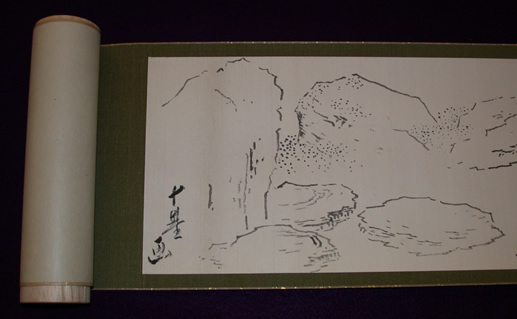 |
| SJG - moonviewing 2010; Roji |
Moonviewing is a traditional Japanese custom of greeting and honoring the full moon on the night of August 15 in the lunar calendar. The moonviewing custom was introduced to Japan from China during Nara and Heian periods (710-1185). Traditionally, Japanese rice cakes and sake are placed on a tray as offering to the moon, together with susuki (pampas grass), arranged in a vase. People view the moon quietly at home, parks, shrines, temples and anywhere they can see it.
Every August in SJG the guests gather in the orchard and wait for the moon to raise over the valley in which the Garden is located, above the moonviewing platform. Music, poetry reading and writing, tea ceremony and quietly enjoying the beauty of the harvest moon are part of the tradition, just as they have been part of traditional moonviewing in Japan for centuries.
This year Marcia Takamura and Chigusa Kitai on koto and shakuhachi filled the air with beautiful music before dusk, while the Kogut Butoh troupe were indeed mingling with guests as coy geisha and rogue samurai. I had trouble to find them at first and asked two passing young women in yukatas: 'are you the coy geishas?' and they gave me a 'look'; nope, they were simply guests in summer kimonos.... The rogue and the coy pair looked much more theatrical, of course, I saw them later.
 |
| SJG - Kogut Butoh Dancers; moonviewing 2010 |
The Haiku Northwest was present with moon-related poetry and a haiku contest. My duties as luminary started at dusk: along with other volunteers I lit the tea candles placed along the path in paper bags and in the paper lanterns on the trees. Now the Garden started to look really magical, Kogut Butoh group was dancing on the moonviewing platform and everybody was glancing on the sky above them waiting for the moon to appear; but apparently it had something better to do and it kept us waiting, only briefly appearing between the clouds.
 |
| SJG - Kobe Lantern |
Perhaps the Seattle Astronomical Society telescopes up at the mountain hills afforded a better view of the sky and stars, but I didn't venture there this year. Have you? I also missed my favorite part of the evening: small boats with candles in them being launched on the pond - a combo of brief rain and darkness sent me to the gate prematurely...
I just looked out of the window: Hey, Mr. Moon - sitting up there in the full glory and with a beautiful white glow - didn't you get a memo from Mary to show up Saturday, like the rest of us?
鳶が鷹を産む。 (Tonbi (or Tobi) ga taka wo umu) Literally: A kite breeding a hawk.
Meaning: A splendid child born from common parents.








